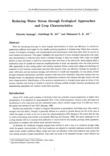Reducing Water Stress through Ecological Approaches and Crop Characteristics
JIRCAS international symposium series
| ISSN | 13406108 |
|---|---|
| NII recode ID (NCID) | AA1100908X |

Full text
intlsymp-10_1-10.pdf351.65 KB
With the increasing shortage in water supply, maximization of water use efficiency is critical for maintaining sufficient food supply for the steadily growing population in dryland areas. Plants have evolved a variety of ecological strategies, and morphological and physiological traits that allow them to survive in water-limited environments. This paper highlights the importance of some ecological approaches and major crop characteristics in reducing water stress in dryland farming. A deep root system with a high root length density in deep soil layers is useful for extracting water held deep in the soil profile. Intercropping offers a substantial scope for spatial and temporal complementarities of water use especially when the crops involved differ appreciably in their rooting pattern and maturity duration. Fallow, conservation tillage and mulching are examples of soil moisture conservation practices that improve water use efficiency through the increase of water infiltration and soil moisture storage, and reduction of runoff and evaporation. In crop plants, several drought resistance mechanisms and their putative traits have been identified. Important among them are drought escape via appropriate phenology, and dehydration avoidance and tolerance through various root and shoot characteristics. Identification of the moisture environments in drought-prone areas in terms of the amount, duration and timing of rainfall is crucial for utilizing suitable drought resistance mechanisms and implementing appropriate soil moisture conservation practices.
| Creator | Shinobu Inanaga Abdelbagi M. Ali Mohamed E. K. Ali |
|---|---|
| Publisher | Japan International Research Center for Agricultural Sciences |
| Available Online | |
| Issue | 10 |
| spage | 1 |
| epage | 10 |
| Language | eng |
